Table of Contents
Introduction: What is Tiramisu?
Tiramisu is one of the world’s most beloved Italian desserts. Known for its light yet creamy texture, Tiramisu combines the rich flavors of espresso-soaked ladyfingers, mascarpone cheese, cocoa powder, and a hint of alcohol to create a balanced and decadent dessert.
The name Tiramisu translates to “pick me up” in Italian, referring to both its caffeine content and its indulgent nature. It is widely enjoyed as a no-bake dessert, making it a popular choice for home bakers and professional chefs alike.
Beyond its heavenly taste, Tiramisu holds a fascinating history that dates back several decades. This article will guide you through the origins, ingredients, step-by-step preparation, variations, and expert tips to help you create the perfect homemade Tiramisu.
Whether you are a dessert enthusiast, a coffee lover, or someone looking to impress guests, mastering Tiramisu will be a delightful experience. Let’s start by exploring the rich history of this classic Italian dessert.
The Origins and History of Tiramisu
The history of Tiramisu is as rich as its flavor. While this dessert is firmly associated with Italy, its origins are often debated. Many food historians credit Treviso, a city in the Veneto region, as the birthplace of Tiramisu. However, some claim that Tiramisu was first created in Friuli Venezia Giulia.
How Tiramisu Evolved Over Time
The first written recipe for Tiramisu appeared in the 1980s, but many believe that similar desserts existed much earlier. One theory suggests that Tiramisu was inspired by Zuppa Inglese, another layered Italian dessert featuring cream, liquor-soaked sponge cake, and chocolate.
In its earliest form, Tiramisu was served in Italian households and small bakeries, with its recipe passed down through generations. Over time, it became a staple in Italian restaurants and eventually gained global popularity.
Today, Tiramisu is a symbol of Italian cuisine, with variations appearing in cookbooks, cafes, and fine dining establishments worldwide. Some modern adaptations incorporate different flavors such as matcha, chocolate, or fruit-based variations, but the classic Tiramisu recipe remains a timeless favorite.
For a deeper dive into the history of Tiramisu, check out this detailed historical account, which traces its roots and evolution.
Key Ingredients in Traditional Tiramisu
The beauty of Tiramisu lies in its simple yet high-quality ingredients. Each component plays a crucial role in delivering its signature taste and luxurious texture.
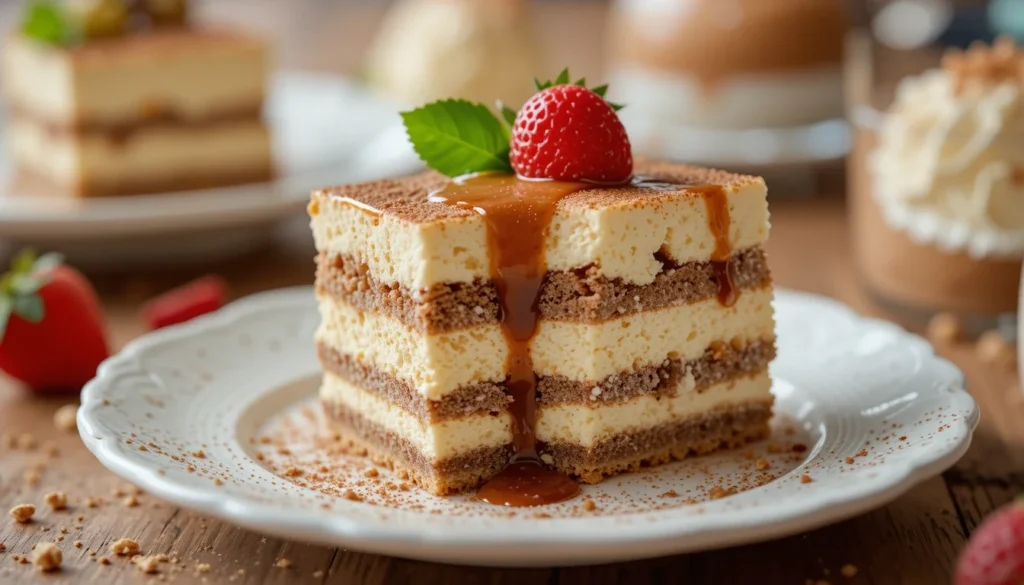
Essential Ingredients
- Ladyfingers (Savoiardi)
- These light, airy biscuits absorb espresso while maintaining their shape, creating the distinct layers of Tiramisu.
- Mascarpone Cheese
- A rich, creamy cheese that provides Tiramisu with its smooth texture. According to this guide, the quality of mascarpone directly impacts the dessert’s final flavor.
- Espresso
- Strong brewed espresso enhances the depth of coffee flavor, making it a key element in Tiramisu.
- Egg Yolks & Sugar
- Traditionally used to create a rich, creamy mascarpone filling. Some recipes use pasteurized eggs to ensure safety.
- Heavy Cream (Optional)
- Some modern recipes incorporate whipped heavy cream for an extra light and airy texture.
- Alcohol (Optional)
- Classic recipes often include Marsala wine, rum, or coffee liqueur, adding complexity to the flavor profile.
- Cocoa Powder
- A dusting of unsweetened cocoa powder provides a bittersweet contrast to the creaminess.
Using fresh, high-quality ingredients is essential to achieving the best Tiramisu experience.
The Science Behind Tiramisu’s Texture & Flavor
Understanding how ingredients interact is crucial for making a perfect Tiramisu.
- Why is Mascarpone Cheese Essential?
- Unlike regular cream cheese, mascarpone is richer and creamier, contributing to Tiramisu’s silky texture.
- The Role of Espresso
- The bitter notes from the espresso balance the sweet mascarpone filling.
- Why Not Over-Soak Ladyfingers?
- Ladyfingers must be lightly dipped in espresso to retain their texture without turning mushy.
- The Importance of Chilling
- Refrigerating Tiramisu for at least 4-6 hours allows flavors to meld together, resulting in the best taste and texture.
The magic of Tiramisu lies in this perfect balance of flavors and textures.
Classic vs. Modern Variations of Tiramisu
Though the classic Tiramisu recipe remains a favorite, chefs and home bakers have experimented with new variations.
Traditional Tiramisu
✅ Uses egg yolks, mascarpone, and espresso
✅ Includes alcohol (Marsala wine or rum)
✅ Topped with cocoa powder
Modern Variations
- Eggless Tiramisu – Uses whipped cream instead of eggs.
- Alcohol-Free Tiramisu – Perfect for kids and non-alcohol consumers.
- Flavored Tiramisu – Options include matcha, chocolate, and fruit-infused versions.
Each variation maintains the essence of Tiramisu while adapting to different preferences.
How to Make Classic Tiramisu (Step-by-Step Guide)
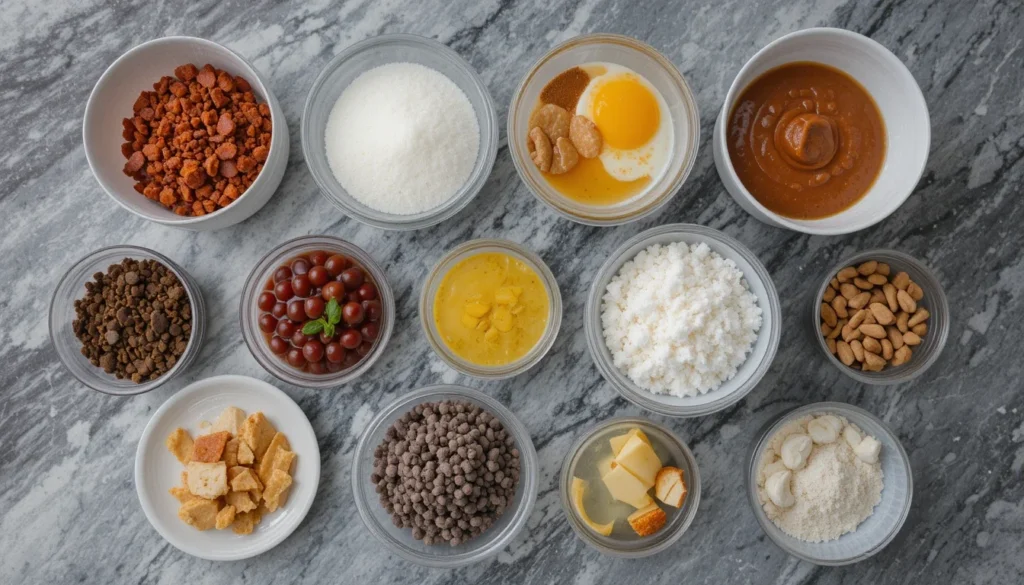
Ingredients (Serves 6-8)
- 24 ladyfingers (Savoiardi biscuits)
- 1 cup strong espresso or coffee, cooled
- 8 oz mascarpone cheese, softened
- 2 large egg yolks
- ¼ cup granulated sugar
- ½ cup heavy whipping cream
- 1 tbsp Marsala wine (optional, can substitute with rum or coffee liqueur)
- 1 tsp vanilla extract
- Unsweetened cocoa powder, for dusting
- Dark chocolate shavings (optional, for garnish)
Step-by-Step Instructions
Step 1: Prepare the Mascarpone Cream
- In a mixing bowl, whisk the egg yolks and sugar together until the mixture becomes pale and creamy. This takes about 2-3 minutes with an electric mixer.
- Add the mascarpone cheese and mix until smooth and fully incorporated.
Step 2: Whip the Heavy Cream
- In a separate bowl, beat the heavy whipping cream until soft peaks form.
- Gently fold the whipped cream into the mascarpone mixture. This keeps the filling light and airy.
- Stir in vanilla extract and Marsala wine (if using).
Step 3: Prepare the Coffee Soak
- Brew strong espresso or coffee and let it cool to room temperature.
- Pour the coffee into a shallow dish. If making an alcoholic Tiramisu, mix in rum, coffee liqueur, or Marsala wine for added depth of flavor.
Step 4: Dip the Ladyfingers
- One at a time, dip each ladyfinger into the coffee mixture for 1-2 seconds per side. Do not soak them too long, or they will become mushy.
Step 5: Assemble the Layers
- Arrange a layer of coffee-dipped ladyfingers in the bottom of a 9×9-inch dish or individual serving glasses.
- Spread half of the mascarpone cream evenly over the ladyfingers.
- Repeat with another layer of coffee-soaked ladyfingers, followed by the remaining mascarpone mixture.
- Smooth the top with a spatula.
Step 6: Chill the Tiramisu
- Cover the dish with plastic wrap and refrigerate for at least 4-6 hours (overnight is best for full flavor development).
Step 7: Add the Final Touches
- Just before serving, dust the top with unsweetened cocoa powder using a fine sieve.
- Garnish with dark chocolate shavings for an extra touch of indulgence.
Step 8: Serve and Enjoy
- Cut into squares or scoop into serving bowls.
- Serve cold and enjoy this classic Italian dessert!
Expert Tips for the Best Tiramisu
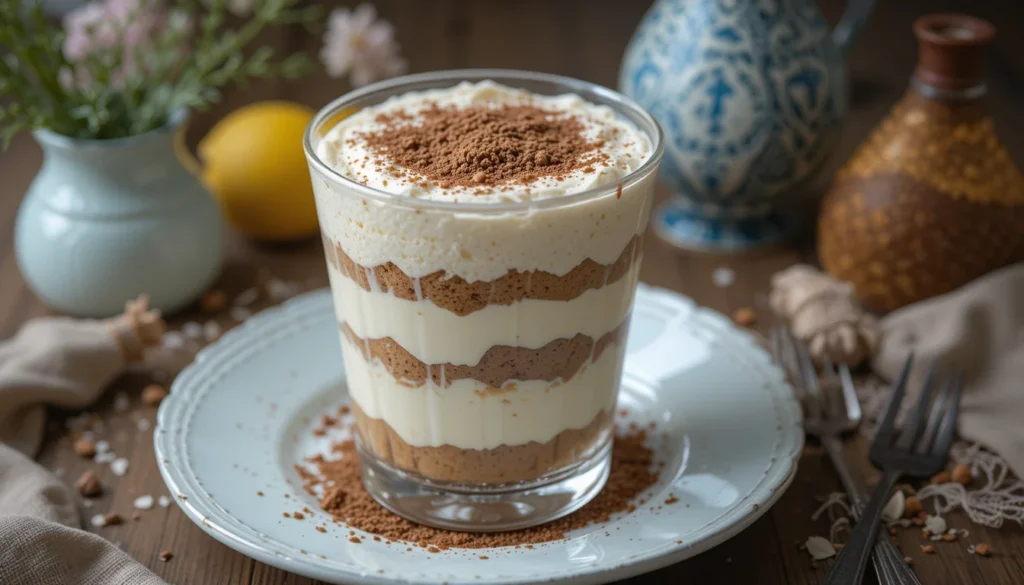
1. Choose High-Quality Ingredients
- Use authentic mascarpone cheese for the creamiest texture. Avoid substitutes like cream cheese unless necessary.
- Brew fresh espresso instead of using instant coffee for the best flavor.
2. Do Not Over-Soak the Ladyfingers
- Dip each ladyfinger for just 1-2 seconds per side. They should be moist but not soggy.
3. Allow the Tiramisu to Chill Properly
- Refrigerate for at least 4 hours, but overnight is ideal. This allows the flavors to meld and the texture to set perfectly.
4. Adjust for Dietary Preferences
- For an egg-free version, skip the yolks and use whipped cream and sugar instead.
- For a kid-friendly version, use decaf coffee and omit the alcohol.
5. Perfect Presentation Tips
- Use a fine-mesh sieve for evenly dusting cocoa powder.
- Serve in individual glasses for an elegant presentation.
Nutritional Information & Dietary Adaptations
Nutritional Breakdown (Per Serving, Based on 8 Servings)
- Calories: ~400 kcal
- Carbohydrates: 40g
- Protein: 7g
- Fat: 22g
- Sugar: 20g
Healthier Alternatives
- Lower-Calorie Option:
- Use low-fat mascarpone or Greek yogurt as a substitute.
- Reduce sugar by using natural sweeteners like monk fruit or stevia.
- Dairy-Free & Vegan Alternative:
- Replace mascarpone with coconut cream.
- Use dairy-free whipped cream instead of heavy cream.
- Swap ladyfingers for vegan sponge cake.
- Gluten-Free Adaptation:
- Use gluten-free ladyfingers or homemade almond flour sponge cake.
Frequently Asked Questions (FAQs) About Tiramisu
1. Can Tiramisu be made in advance?
Yes! Tiramisu actually tastes better when made in advance. It needs at least 4-6 hours in the refrigerator for the flavors to blend, but for the best results, let it chill overnight.
2. How long does Tiramisu last in the fridge?
Homemade Tiramisu stays fresh in the refrigerator for 2-3 days. Make sure to cover it tightly with plastic wrap or an airtight lid to prevent it from drying out or absorbing other odors.
3. Can you freeze Tiramisu?
Yes, Tiramisu can be frozen for up to 3 months. Wrap it securely in plastic wrap and then in foil to preserve its texture. When ready to eat, thaw it in the refrigerator overnight before serving.
4. What is the best alcohol for Tiramisu?
Traditional Tiramisu uses Marsala wine, but other great options include dark rum, coffee liqueur (like Kahlúa), or brandy. If you prefer an alcohol-free version, simply skip the alcohol or use vanilla extract as a substitute.
5. Can I make Tiramisu without eggs?
Yes! You can make an eggless Tiramisu by substituting the egg-based mascarpone mixture with whipped cream and sugar. This results in a lighter but equally delicious dessert.
6. Why is my Tiramisu too watery or soggy?
This usually happens if:
- The ladyfingers were soaked too long in espresso. They should be dipped quickly to avoid becoming too soft.
- The mascarpone mixture was overmixed, causing it to break down.
- The Tiramisu wasn’t chilled long enough. It needs time to set properly.
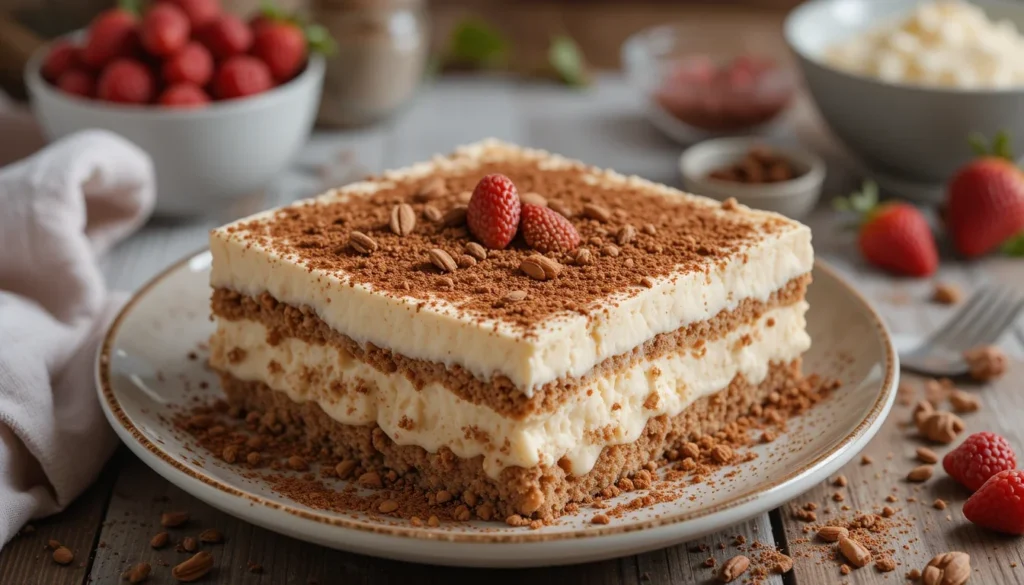
7. What can I use instead of Mascarpone Cheese?
If you can’t find mascarpone cheese, you can substitute it with a mixture of:
- Cream cheese + heavy cream + butter
- Ricotta cheese (blended for smoothness)
- Greek yogurt (for a lighter version)
8. Can I use instant coffee instead of espresso?
Yes, but freshly brewed espresso gives the best flavor. If using instant coffee, make it extra strong by dissolving 2-3 teaspoons in ½ cup hot water.
9. How do I make a kid-friendly Tiramisu?
To make Tiramisu suitable for kids:
- Skip the alcohol.
- Use decaffeinated espresso or hot chocolate instead of regular coffee.
- Reduce the cocoa powder dusting if kids don’t like the slightly bitter taste.
10. What’s the best way to serve Tiramisu?
Tiramisu should be served cold, directly from the fridge. For extra flavor, dust it with fresh cocoa powder and garnish with chocolate shavings or fresh berries just before serving.
Conclusion: Why You Should Try Making Tiramisu
Tiramisu is a true masterpiece in the world of desserts. Its rich coffee-infused layers, creamy texture, and bittersweet cocoa finish make it a favorite worldwide. Just like other no-bake desserts, such as this refreshing Lemon Eclair Cake, Tiramisu is easy to prepare and incredibly satisfying.
With this detailed guide, you now have everything you need to make the perfect homemade Tiramisu. Whether you stick to the classic Italian recipe, much like traditional Lasagna, or experiment with chocolate-infused versions, like this decadent Chocolate Cake, one thing is certain—Tiramisu will always be a crowd-pleaser!
So, grab your espresso, mascarpone, and ladyfingers, and start creating your own delicious Tiramisu today! And if you’re in the mood for more coffee-flavored desserts, don’t forget to check out this indulgent Coffee Cake or treat yourself to other sweet delights!

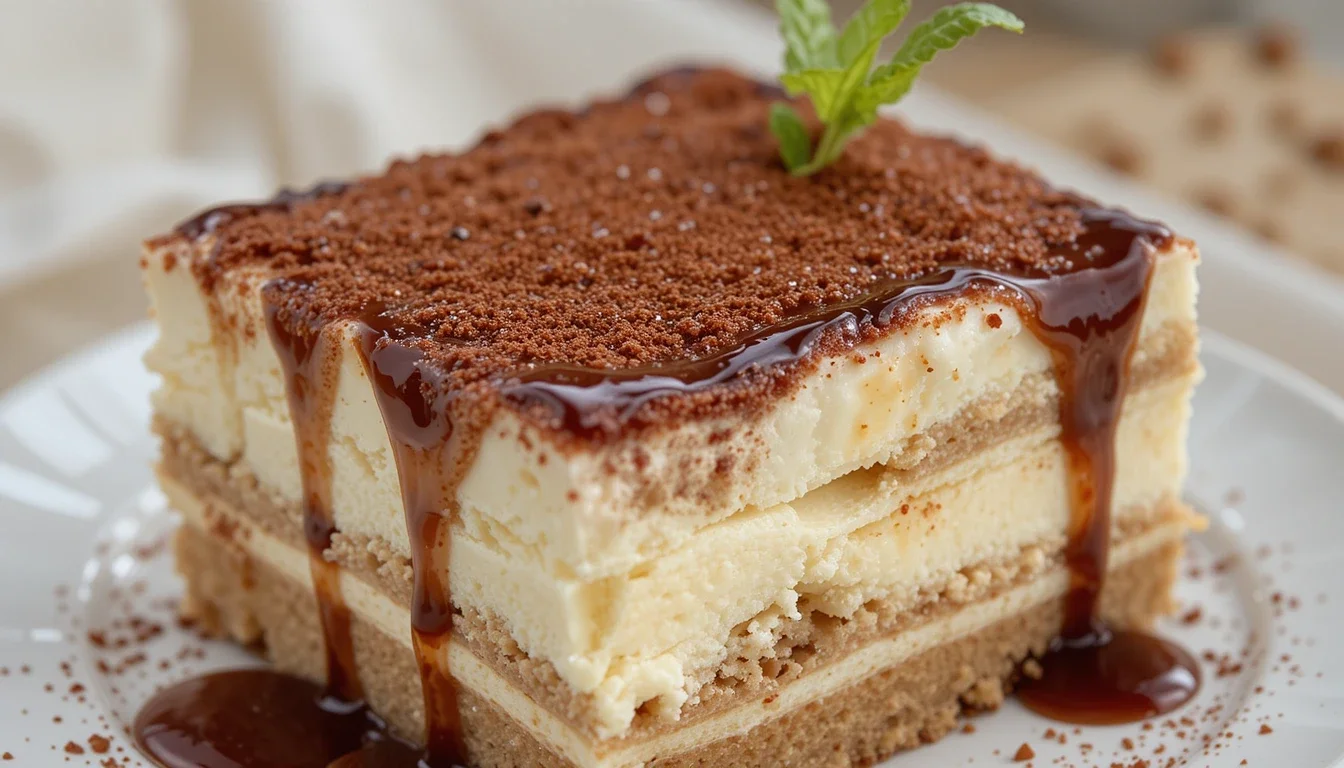
1 thought on “Classic Tiramisu Recipe – 7 Easy Steps to Make Authentic Italian Dessert”